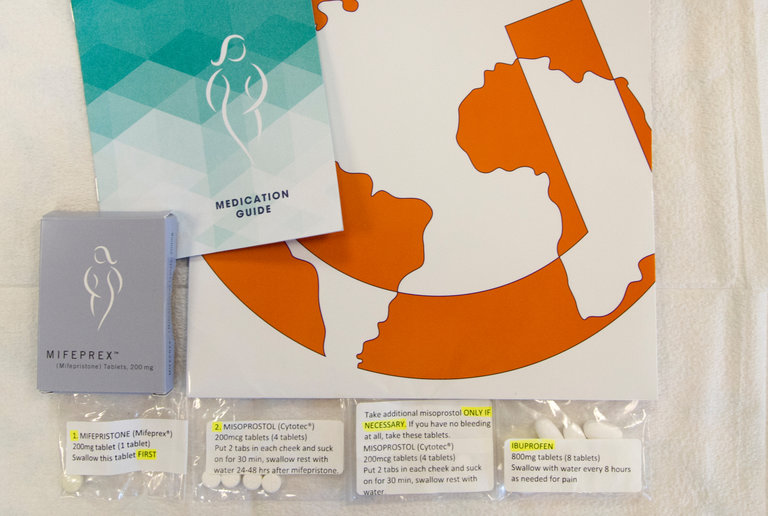By Lydia Blaisdell
For this post, we’re going to explore the differences between medication abortion (the abortion pill) and in-clinic abortion (“surgical” abortion) for an early pregnancy.
First, I want to counter a few commonly held misconceptions about abortion procedures in general. There’s an idea that abortion procedures present safety risks to patients. In fact, according to the Guttmacher Institute, “Abortion is one of the safest surgical procedures for women in the United States. Fewer than 0.05% of women obtaining abortions experience a complication.” Continuing a pregnancy is 14 times more dangerous than obtaining an abortion procedure.
Current Texas laws require women who wish to get an abortion to undergo a 24-hour waiting period, so the procedure can take at least two consecutive days. Texas also restricts access to abortion after 22 weeks since your last menstrual period, so be sure to contact an abortion clinic as soon as you suspect you may be pregnant to discuss your abortion options.
If you’re under 18 and located in Texas and worried about obtaining parental permission, please contact us at Jane’s Due Process. You can get permission from a judge to have the abortion without your parents’ consent or knowledge. This is called judicial bypass, and information about how to begin the process is available here.
If you have questions about finding financial support to access abortion care, please see our past post on options for assistance.
Back to the topic of medication vs. surgical abortion procedures, let’s explore a few common questions.
How far along in the pregnancy can I be?
Medication abortion is an option up to 10 weeks from the first day of your last period.
Surgical abortion is performed in Texas up to 22 weeks, but the procedure changes a bit starting around 18 weeks. Obtaining a surgical abortion after 12 weeks can take more time at the clinic and it may be more expensive.
Abortions after 22 weeks from your last menstrual period are not permitted in the state of Texas, but are possible to obtain in some other states. The closest state to Texas that allows abortions past 22 weeks is New Mexico.
What is a Medication Abortion?
Medication abortion is performed by the patient at home by taking a series of pills in sequence. The first pill (mifepristone) is taken at the clinic, and stops the development of the pregnancy. It may induce nausea. 6-72 hours later, the patient takes four misoprostol pills. Once the misoprostol is inserted (vaginally, inside the cheek, or under the tongue), the patient may experience significant cramping and bleeding for several hours. The medication abortion is very similar to a miscarriage. Often pain pills are prescribed to ease these cramps. A follow-up appointment with a provider will confirm that the procedure was successful.
Reasons to choose this method include: wanting the abortion to feel more like a natural miscarriage, wanting to do the procedure at home instead of in a doctor’s office, and the potential for privacy. Potential downsides to this method include that you’ll be having a lot bleeding (including clots up to the size of a golfball or small lemon) and pretty bad cramping over a relatively long time period (can take 1-2 days).
Surgical Abortion Overview
An in-clinic or surgical abortion procedure occurs entirely within a doctor’s office or clinic. The actual abortion procedure only takes 5 to 15 minutes, and it isn’t true surgery – there are no incisions or sharp instruments. Before the abortion, the patient is prepped by taking misoprostol or another medication to dilate the cervix. Under 13 weeks, suction is used to remove the pregnancy from the uterus. This is called a vacuum aspiration abortion. After 13 or 14 weeks, the cervix is dilated, instruments are placed into the uterus, and the uterus is emptied with suction and instruments. A version of this particular procedure has been done for over 40 years. The clinic will use IV sedation or other pain medication drugs to relieve pain during the procedure. After the procedure, you will probably be very sleepy, and should take the rest of the day to rest if you can. You can usually resume normal activities the following day, taking it easy if you need.
Advantages to the in-clinic procedure include: having medical staff to supervise and support you, and less bleeding than the medication method. Before you leave the clinic, the doctor will ensure that the abortion was complete. This method does require a companion or caretaker to help you return home after the clinic. There also may be side effects from the anesthetics used during the procedure.
Is one method more effective or safe?
Both methods are effective over 98% of the time. Surgical abortion is slightly more effective at 99%. If the medication abortion fails, you will likely need a surgical abortion. The most common complication (occurring in about 1% of medication abortions) is an incomplete abortion, which requires more medication or a vacuum aspiration procedure.
Both methods are very safe, with fewer than 0.05% of patients experiencing serious complications.
Neither of these methods are effective for tubal or ectopic pregnancies. These pregnancies, where the fertilized egg implants outside the uterus, must be addressed immediately by a doctor.
Will these procedures affect my future fertility?
Not a bit! Neither procedure has been shown to alter the future fertility of women. In rare cases there can be infections from both procedures, but the likelihood of infection is quite low. The clinic will give you antibiotics & aftercare instructions to prevent infection.
You can get pregnant again right away after having an abortion. If you choose to, you can opt to have an IUD inserted at some clinics after a surgical abortion. You can also begin taking any other form of birth control immediately after an abortion. Teens in Texas can get birth control without parental consent at Title X clinics.
Which method is better?
Every person’s body and emotional response to an abortion procedure is different. We recommend speaking candidly with your medical provider to determine which method is best for you.
Can I bring a loved one with me to my appointments?
Most clinics will allow you to bring a loved one to your appointments. Depending on the clinic’s policies, you may not be allowed to have your companion in the room during the a surgical abortion procedure.
Generally, having someone to support and care for you after the procedure is recommended no matter which method you choose. We recommend having some favorite snacks, a hot pack, and relaxing activities (watching a movie, writing in a journal) ready for after your procedure.
No matter which procedure you choose, we can help you find a clinic and obtain a judicial bypass if you need one. Call or text our hotline at 866-999-5263 for help.
We are not doctors, and nothing in this post is medical advice. Please contact your nearest abortion clinic to find out more information about each procedure.
Like what you’ve read? Donate to support Jane’s Due Process!




